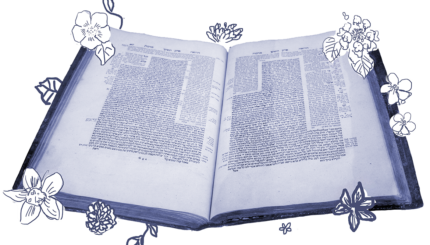One of my absolute favorite Jewish expressions is found in one of the most outlandish stories in the Talmud (collection of commentaries and stories explaining Jewish law and tradition). This is a pretty lofty thing to achieve, given how strange some parts of the Talmud are, but I really do think that this particular story about Rav Kahana might take the cake.
In tractate (thematic section of Talmud) Berakhot 62a:3, Rav Kahana follows his teacher, Rav, home and hides under Rav’s bed. He waits there, listening and observing, when Rav and his wife get into bed together. When Rav discovers Rav Kahana in the bedroom, he scolds him and says such voyeurism is not how people should behave. Rav Kahana defends his actions by saying: “This, too, is Torah, and I must learn!”
While the story is a strange one, I find that Rav Kahana’s statement “this, too, is Torah, and I must learn” is actually a motto that makes sense to me. It asserts that Torah comes from many sources, learning can happen anywhere, and even unconventional or new sources of wisdom are fonts of tradition nevertheless.
Part of what fascinates me about this quote is the definition that Torah takes on. In the strictest sense of the word, Torah means the five books of Moses—the scroll we read from on Shabbat and holidays, full of the stories, personages, and laws that shape the Jewish people.
In a less strict definition, Torah comes to encompass the Mishnah and Talmud, also called the Oral Torah. This body of stories, laws, teachings, and arguments is generally less familiar to broader Jewish audiences, but still forms an important part of the mitzvah (commandment) of Talmud Torah, the study of Torah.
But Rav Kahana’s invocation of “this, too, is Torah!” encompasses a much broader and more abstract definition of Torah. It indicates that what people do and say is Torah as well. How can this be? Well, in the book of Deuteronomy, we read the words “lo bashamayim hi,” meaning that the Torah is not in the heavens, but here on earth with us.
When I pose a question to a religious school classroom and a kindergartner comes up with an answer from way out in left field, this answer, too, is Torah, and I can learn from them. When someone tells me about their Jewish journey, this story, too, is Torah and I can learn from them. When people who find themselves marginalized in Jewish spaces (women, Jews of color, LGBTQ+ Jews, and on and on) express their experiences, this, too, is Torah and I can learn from them.
In fact, if all this, too, is Torah, not only can I learn from these people, but it is my sacred duty, a mitzvah (commandment), to study their Torah. Thus the motto “this, too, is Torah” reminds me of the commitment I have made as a Jewish professional to creating inclusive, welcoming, and diverse communities. When Torah is sourced from us all, it reaches us all in the ways we best connect, and brings everyone’s voices and experiences into the canon of Jewish tradition.



